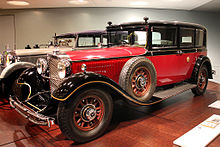Pullman body
The Pullman body is a design for car bodies . In contrast to subsequently extended stretch limousines , cars with a Pullman body were originally designed and manufactured in this way, which is why the chassis with the longest available wheelbase within a series was usually used.
definition
In the automotive industry, the term is Pullman (often written as Pullman) for large, luxurious touring car and VIP - automobiles . Up until the Second World War, the highly individual vehicles were made by companies specializing in special bodies.
The oldest known German definition of the term can be found in drivers and motor vehicles from 1928.
DIN 70010 "System of road vehicles"
The term appears as early as March 1959 in German standards, namely in the DIN 70011 standard “Superstructures for passenger vehicles; Terms and concepts ”. This required 5 or more seats, regardless of their arrangement, and a "partition with crank or sliding window between the front and rear seats".
According to the more recent German DIN standard 70010 "Systematics of road vehicles" from April 1978, which is coordinated with the international standard ISO 3833–1977 "Road vehicles - Types - Terms and Definitions", the Pullman limousine is defined as a passenger car
- with closed structure
- with a fixed, rigidly connected roof
- with four or more seats in two or more rows of seats
- with four or six side doors
- with six or more side windows
In the specialist literature
A German-language reference work from 1952 differentiates between two Pullman bodies, which are described in detail as:
- Pullman limousine: Closed body, 2–3 rows of seats, 4–8 seats, 4 doors, partition behind the driver's seat. Common in European countries.
- Pullman Cabriolet: 2 rows of seats, 4–7 seats, 4 doors. Fully closable and openable hood with retractable side windows and partition behind the driver's seat. Common in Germany, France and Great Britain.
The specialist book author Halwart Schrader explains in a reference work on the keyword "Pullman":
- “ Until the end of the 1930s, the Pullman limousine (so named after the luxuriously furnished railroad car of the American industrialist George Mortimer Pullman ) was the name given to those passenger cars that had additional emergency seats in the rear and thus offered space for at least seven people and had a separating window . "
Origin of the name
The name is derived from the Pullman Palace Car Company and its founder, the American George Mortimer Pullman . In the pioneering days of automotive engineering, automakers mostly only delivered cars as chassis with an engine. The Pullman Palace Car Company was one of the companies that manufactured the bodies. However, from 1858 the company and its founders became known primarily for their comfortable sleeping cars ( Pullman cars ). The appeal of the name Pullman remained so great at the turn of the century that the industrialist AP Broomell also called the luxury car brand, founded in 1905, Pullman .
In the present, the name Pullman, at least in German-speaking countries, is mainly used for the Mercedes-Benz Pullman ; these vehicles have been produced since 1963 until today.
Examples of vehicles with Pullman versions

- Mercedes-Benz 770 ("Great Mercedes") (1930–1938)
- Opel 6 (1934)
- Humber Pullman (1945-1954)
- Lancia Aurelia B 15 (only 1953)
- Borgward Hansa 2400 (1953-1958)
- BMW 505 (1955/56)
- Mercedes 600 (1964)
- Mercedes-Benz Pullman (various models)
- Aurus Senate (2019)
Related terms
- Imperial Limousine : Term used by Cadillac in the 1920s and 1930s for Pullman limousines. They were manufactured by Fleetwood respectively. upgraded.
- Vestibule limousine (also as sedan): The rear door, which is usually rounded at the top, protrudes into the roof so that the vehicle can be entered and exited upright. This shape went out of fashion in the early 1920s. Manufacturers such as Pierce-Arrow or Packard had them in their regular programs.
Remarks
- ↑ Not available; as an English quote found in coachbuilt.com: Terminology.
Web links
- coachbuilt.com: Terminology. (Accessed August 31, 2017)
Individual evidence
- ↑ a b c coachbuilt.com: Terminology.
- ↑ Motor vehicles in words and pictures - 100 cars . Verlag für Handel und Wirtschaft - Müller & Co., Dept. Auto and Motorcycles, 1st edition. Munich 1952. p. 7 (Chapter: The most important passenger car bodies).
- ↑ Halwart Schrader : vintage lexicon: history, brands, technology from A-Z . BLV Verlagsgesellschaft, 2nd edition. Munich / Vienna / Zurich 1981. ISBN 3-405-11934-0 , p. 115 (keyword: Pullman).


